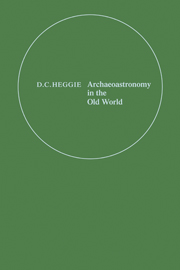Book contents
- Frontmatter
- Contents
- PREFACE
- LIST OF CONTRIBUTORS
- INVITED PAPERS
- MEGALITHIC ASTRONOMY: HIGHLIGHTS AND PROBLEMS
- ARCHAEOLOGY AND ASTRONOMY: AN ARCHAEOLOGICAL VIEW
- THE STATISTICAL APPROACH
- STATISTICAL AND PHILOSOPHICAL ARGUMENTS FOR THE ASTRONOMICAL SIGNIFICANCE OF STANDING STONES WITH A SECTION ON THE SOLAR CALENDAR
- MEGALITHIC ASTRONOMICAL SIGHTLINES: CURRENT REASSESSMENT AND FUTURE DIRECTIONS
- ASPECTS OF THE ARCHAEOASTRONOMY OF STONEHENGE
- IMPLICATIONS FOR ARCHAEOLOGY
- PI IN THE SKY
- CONTRIBUTED PAPERS
- INVITED PAPER
- INDEX
THE STATISTICAL APPROACH
Published online by Cambridge University Press: 05 November 2011
- Frontmatter
- Contents
- PREFACE
- LIST OF CONTRIBUTORS
- INVITED PAPERS
- MEGALITHIC ASTRONOMY: HIGHLIGHTS AND PROBLEMS
- ARCHAEOLOGY AND ASTRONOMY: AN ARCHAEOLOGICAL VIEW
- THE STATISTICAL APPROACH
- STATISTICAL AND PHILOSOPHICAL ARGUMENTS FOR THE ASTRONOMICAL SIGNIFICANCE OF STANDING STONES WITH A SECTION ON THE SOLAR CALENDAR
- MEGALITHIC ASTRONOMICAL SIGHTLINES: CURRENT REASSESSMENT AND FUTURE DIRECTIONS
- ASPECTS OF THE ARCHAEOASTRONOMY OF STONEHENGE
- IMPLICATIONS FOR ARCHAEOLOGY
- PI IN THE SKY
- CONTRIBUTED PAPERS
- INVITED PAPER
- INDEX
Summary
Abstract. A brief summary is given of the need for a statistical approach to assessing most archaeoastronomical data and theories. The various ways in which selection biasses can lead to misleading conclusions, or at least seriously diminish the value of observed data, are described and a few possible techniques for making allowances for them are suggested. A set of three idealistic rules is stated in the hope of improving future observational work. Finally a brief analysis is made of a particular set of data that satisfies nearly all the requirements for lack of bias.
The subject of statistics has, on the whole, a pretty bad public image. Even among scientists it is usually regarded as a necessary evil, a hoop through which one's data must jump before getting accepted for publication. Archaeoastronomers don't even seem to have got this far, since most papers and talks at conferences seem oblivious of the need for taking any kind of statistical view of the data presented. I very much hope that two recent excellent works (Heggie 1981 a, b) will rapidly change this attitude and I strongly recommend all readers of this article to consult both these references. They make nearly all the points that I should have wished to make, so I need not repeat them here.
We do not need statistics to help assess the evidence for midsummer sunrise at Stonehenge or midwinter sunrise at Newgrange.
- Type
- Chapter
- Information
- Archaeoastronomy in the Old World , pp. 45 - 52Publisher: Cambridge University PressPrint publication year: 1982
- 1
- Cited by



